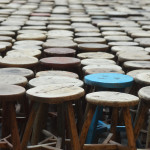On my way back to Oaxaca after a few weeks in California, I was struck immediately by the presence of certain buildings in Mexico City. When in Mexico for a long time, your eyes get used to them, but after a while outside, they strike you again—there are certain hulking unfinished or decaying monstrosities of buildings, gray slabs crumbling and soot-covered, naked walls, bristling with rebar—that are, like the gargoyles perched on the churches in Prague, hellish in a baroquely imaginative way.
I always describe Mexico City’s finer points to people who haven’t been there, mentioning the beautiful neighborhoods, trees and monuments, cosmopolitanism and urban vibrancy. But Mexico City is exciting exactly because it has all those things, and at the same time is a sprawling, chaotic, dystopian urban nightmare beyond any science fiction movie.
Like Ruben Gallo writes in “Delirious Mexico City,” his introduction to The Mexico City Reader, those who’ve embraced Mexico City have “fallen in love with the circus’s bearded lady.” To love el D.F. is to also to know and love the beard.
Gargoyles on medieval churches in Prague twist down from above, the tortured souls of sinners vomiting rain into an eternity, or demons leering at the fear of the parishoners far below. The fearsome buildings in Mexico City, of course, are unlike those gargoyles in that they were not intentionally built to intimidate and terrorize. But the emotional response of shock and fascination is the same.
Some rise like abandoned space ships, rusting in the ozone and the tropical rain, opaque and blunt, all metal and concrete, windowless cubes where inside, there might be a factory or a warehouse, or off-the-books housing. Others are uninhabitable by anyone and open to all—cinder block ruins, giant frames of steel, rebar splayed like fishbones, only the occasional graffiti and encroaching vines to liven them up.
They are really amazing, in the sense of disaster and doom they evoke. Some of them inspire a sense of hopelessness, abandonment, and others, actual fear, since they seem to hint at horrible scenes of desolation, poverty, and war.
Cities are always changing, and the gargoyles of Mexico City will one day be swept away. Which is why these buildings should be documented, collected. Doomed as they are to be condemned as blight, they should be captured now in as much detail as possible, so that the Mexico City of the future will know the ruins of its past.








Not just Mexico City, but all of Mexico -she is, the beauty and the beast!